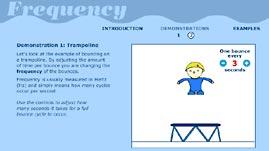Teachers' Domain - Digital Media for the Classroom and Professional Development
User: Preview

Source: The ASPIRE Lab, University of Utah
In this interactive activity adapted from the University of Utah's ASPIRE Lab, learn about the frequency and period of an oscillating object. Vary the time it takes a child to jump up and down on a trampoline to see how that changes the frequency of the jumping motion. Next, change the period of a pendulum by adjusting the length of its string and see the mathematical relationship between period and frequency. Finally, see how the electromagnetic spectrum consists of a range of frequencies.
When an object moves back and forth repeatedly around a point, it is said to oscillate. For example, if you jump up and down over and over again, you go through a repeating cycle of crouching and being in the air. A single cycle of up and down movements is one oscillation. Waves are oscillating disturbances that move through space, which scientists have agreed to visually represent as having a sinusoidal shape—the familiar S-shape. The points of maximum displacement in the positive or negative direction are known as the "crests" and "troughs" of a wave.
Imagine a boat floating on the surface of the ocean. As water waves pass under the boat, it bobs up and down; the boat goes up on the crest of a wave and down on a trough. One oscillation (for example from crest to crest or trough to trough) is one complete wave cycle. The rate of oscillation is called the frequency of the wave. In other words, the frequency is a measure of the number of wave cycles that occur in a given amount of time. For example, if the boat were bobbing up and down at a fast rate, the waves would have a high frequency. Similarly, a high-frequency sound wave (heard as a high-pitched tone) is produced by a fast rate of vibration. On the other hand, a low-frequency sound wave (low-pitched tone) is produced by a slow rate of vibration.
The frequency of a wave is also related to its wavelength—the length of one complete cycle. The product of frequency and wavelength equals the speed of a wave. In the case of light waves, because all light travels at the same speed, the shorter the wavelength of light, the higher its frequency. The electromagnetic spectrum is the range of all possible wavelengths and frequencies, spanning from very long wavelengths and low frequencies (radio waves) to very short wavelengths and high frequencies (gamma rays).
By convention, we usually describe X-rays and gamma rays in terms of energy; ultraviolet, optical, and infrared light in terms of wavelength; and radio waves in terms of frequency. A common unit for frequency is cycles per second or Hertz (Hz), named after Heinrich Hertz, a German physicist who was the first to demonstrate the existence of electromagnetic waves. You may have noticed that your FM radio has units of MHz. Radio stations broadcast at specific frequencies in order for your radio receiver to be able to pick up their signal. If you tune your radio to listen to 98.5 on the FM dial, you are tuning in to the station that is broadcasting a signal of radio waves at a frequency of 98,500,000 cycles per second.
 Loading Standards
Loading Standards Teachers' Domain is proud to be a Pathways portal to the National Science Digital Library.
Teachers' Domain is proud to be a Pathways portal to the National Science Digital Library.
